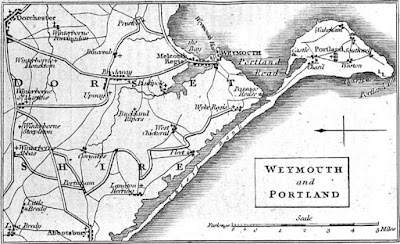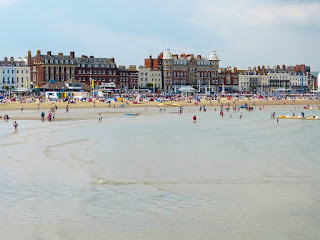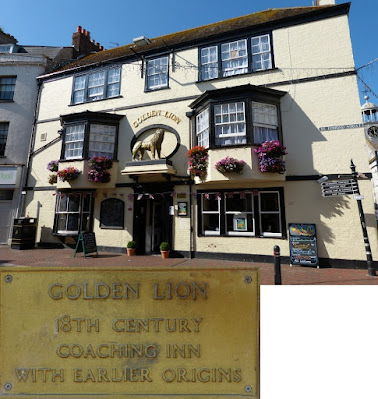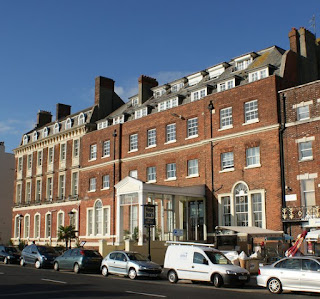 |
| Map of Weymouth and Portland from Weymouth and Melcombe Regis New Guide (1835) |
Weymouth was historically two towns, one on each side of the harbour, which was protected by the Nothe headland. Melcombe Regis lay to the north, between the sea and the backwater, and Weymouth to the south, and they were connected by a bridge. In 1770, a new seven-arched wooden bridge was built, with a drawbridge in the middle to let tall boats through.
The rise of tourism
After the Civil War, Weymouth lost much of its trade to Poole and its importance as a port declined. But in the 18th century a new trade grew up – tourism. Repeated outbreaks of plague had made the wealthy very health conscious giving rise to the growth of spa towns such as Bath and Harrogate. Then a more revolutionary cure developed: sea bathing. Weymouth, with its sheltered bay and golden sands, was ideally suited and entrepreneurs eagerly sought to capitalise on this.
The turnpike roads
During the second half of the 18th century, the transport system in England was revolutionised by the introduction of turnpike roads – roads which were funded by the collection of tolls. In 1761, an Act was passed to create a turnpike road from Dorchester to Weymouth, much improving access to the town.
 | |
| A toll house Weald and Downland Museum |
Weymouth could be approached by travelling down the turnpike road from Dorchester and then descending the hill through the village of Upwey. The road, called the Narrows, then passed along the seafront with the backwater on the other side, separated from the Esplanade by a chain and post fence.
Weymouth entrepreneurship
On 30 September 1748, Prowse and Bennet were granted twenty-one year leases so that they could build two wooden bathing houses on the north, Melcombe Regis, side of the harbour, to exploit the new fashion for sea bathing.
The birth of the assembly rooms
Another entrepreneur, Andrew Sproule, took a lease on land north of Melcombe Regis on which he built a hotel and assembly rooms. Stacie’s Hotel, named for its proprietor, opened for its first season in 1773 and all the apartments were fully booked. It later became the Royal Hotel.
A bid for a better Weymouth
The governing Corporation was keen to develop the town and attract more visitors. In 1776, an Act of Parliament was passed which allowed them to raise money for town improvements by levying a tax on owners and shopkeepers. The money raised was spent on making Weymouth a safer, cleaner, more attractive place to visit.
 |
| Weymouth seafront (2012) |
As a result of the Act, the main streets were paved and drained and lit by street lamps. Watchmen were appointed to patrol the streets to maintain the peace and help visitors and inhabitants alike feel safe. Vandalism was guarded against by threatening fines of up to 40 shillings for the wilful destruction of the new lamps. Riding or driving horses or cattle on the footpaths was also prohibited.
Fire prevention
The Act attempted to combat the very real danger of fire that existed because of the number of dwellings in close proximity to each other by forbidding the use of thatch. All new buildings had to use tile, slate or lead and existing thatch had to be replaced by the beginning of 1794.
In 1792, the Corporation established a fire service of twelve men to operate the two fire engines from March to September. Each man was to be paid six pence. In 1797, a private company was set up to pipe water throughout Melcombe ensuring a good water supply to combat fire.
Congestion
Traffic flow was also tackled by the 1776 Act. Carts were frequently held up because their way was obstructed by another vehicle blocking the road, often resulting in unpleasant shouting matches or fighting. The Act introduced a fine of five shillings on any wagon, cart, dray or carriage left standing in the road longer than necessary for loading and unloading.
Guidebooks
By the 1770s, Weymouth’s summer season was well-established. Guidebooks were issued promoting the town for health and leisure. The post-mistress, Mrs Delamotte, first issued her Weymouth Guide in 1782, followed by Harvey’s Improved Guide in 1800.
They described the fashionable entertainments available as well as the accommodation on offer. This included hotels such as the Crown Inn in St Thomas Street, the King’s Head in Maiden Street and the Golden Lion in St Mary’s Street. It also included lodging houses which were expensive, but single gentlemen could be accommodated on moderate terms all year round.
 |
| The Golden Lion St Mary's Street, Weymouth |
On 18 September 1750, Ralph Allen purchased a property on the Weymouth side of the harbour. He had been advised to try sea bathing for his health and Weymouth was his resort of choice. Allen had made his fortune reforming the British postal system and had then acquired quarries in Bath which provided the stone for the building of Georgian Bath.
He visited Weymouth regularly from 1750 until his death in 1764. He was a man of great wealth and influence and many important people visited him there, including the Duke of York in 1758.
After the Duke of York came the Duke of Gloucester who commissioned his own house in Weymouth in 1780, Gloucester House. It was this house that he lent to his brother, George III, when he needed to recuperate from a severe bout of incapacity in 1789.
 |
| Gloucester House on Weymouth seafront (2012) |
Thus Royal Weymouth was born. George fell in love with the town and visited repeatedly until 1805.
Updated 5 March 2020
Rachel Knowles writes clean/Christian Regency era romance and historical non-fiction. She has been sharing her research on this blog since 2011. Rachel lives in the beautiful Georgian seaside town of Weymouth, Dorset, on the south coast of England, with her husband, Andrew.
Find out more about Rachel's books and sign up for her newsletter here.If you have enjoyed this blog and want to encourage me and help me to keep making my research freely available, please buy me a virtual cup of coffee by clicking the button below.
Sources used include:
Boddy, Maureen and West, Jack, Weymouth, an illustrated history (The Dovecote Press, 1983, Wimborne)
Chedzoy, Alan, Seaside Sovereign - King George III at Weymouth (The Dovecote Press, 2003, Wimborne)
Feltham, John, Editor of the Picture of London, A Guide to all the Watering and Sea-Bathing Places (1815)
Groves, E, The Weymouth and Melcombe Regis New Guide (E Groves, 1835, Weymouth)
Hibbert, Christopher, George III (1998, Viking, Great Britain)
Simpkin & Marshall, Weymouth as a Watering Place (Simpkin & Marshall, 1857, London)
Photographs © RegencyHistory.net


I enjoyed reading about the history of my one-time home town.
ReplyDeleteAnd what a wonderful town it is. :)
DeleteGreat read, now living away, but worked at the Royal Hotel, lived near Maiden Street, so very interesting.
ReplyDelete